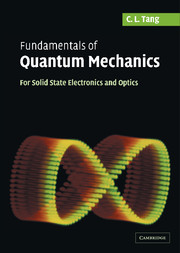Book contents
- Frontmatter
- Contents
- Preface
- 1 Classical mechanics vs. quantum mechanics
- 2 Basic postulates and mathematical tools
- 3 Wave/particle duality and de Broglie waves
- 4 Particles at boundaries, potential steps, barriers, and in quantum wells
- 5 The harmonic oscillator and photons
- 6 The hydrogen atom
- 7 Multi-electron ions and the periodic table
- 8 Interaction of atoms with electromagnetic radiation
- 9 Simple molecular orbitals and crystalline structures
- 10 Electronic properties of semiconductors and the p-n junction
- 11 The density matrix and the quantum mechanic Boltzmann equation
- References
- Index
9 - Simple molecular orbitals and crystalline structures
Published online by Cambridge University Press: 05 June 2012
- Frontmatter
- Contents
- Preface
- 1 Classical mechanics vs. quantum mechanics
- 2 Basic postulates and mathematical tools
- 3 Wave/particle duality and de Broglie waves
- 4 Particles at boundaries, potential steps, barriers, and in quantum wells
- 5 The harmonic oscillator and photons
- 6 The hydrogen atom
- 7 Multi-electron ions and the periodic table
- 8 Interaction of atoms with electromagnetic radiation
- 9 Simple molecular orbitals and crystalline structures
- 10 Electronic properties of semiconductors and the p-n junction
- 11 The density matrix and the quantum mechanic Boltzmann equation
- References
- Index
Summary
With the basic quantum theory of atomic systems developed in the previous chapters, it is now possible to address the question, at least in a qualitative way, of how atoms can be held together to form molecules and crystalline solids. The explanation is based on the time-independent Schrödinger equation, which is solved on the basis of time-independent perturbation theory.
When the atoms are brought together, the electrons and ions in the atoms interact also with the positive charges in the nuclei and the electrons of the neighboring ions. Quantum mechanically, it may be energetically more favorable for the atoms to form molecular complexes than to exist as separate atoms. A simple molecular orbital theory of “covalent bonded” diatomic molecules is introduced. This model can lead to a qualitative understanding of, for example, some simple sp, sp2, or sp3 bonded organic molecules, and sp3bonded tetrahedral complexes that are the basic building blocks of such important IV–IV elemental semiconductors as Si and Ge and various III–V and II–VI compound semiconductors such GaAs, GaP, ZnS, and CdS. The basic geometry of the atomic orbitals of the constituent atoms determines the structures of the tetrahedral complexes, which in turn determine the crystalline structures of the solids. Of particular interest are semiconductors with broad applications in electronics and photonics.
Time-independent perturbation theory
The key to solving the time-dependent Schrödinger equation is to solve the corresponding time-independent Schrödinger equation. Yet, in the vast majority of cases, the time-independent Schrödinger equation cannot be solved exactly analytically.
- Type
- Chapter
- Information
- Fundamentals of Quantum MechanicsFor Solid State Electronics and Optics, pp. 135 - 150Publisher: Cambridge University PressPrint publication year: 2005



